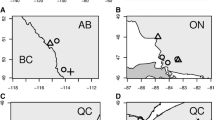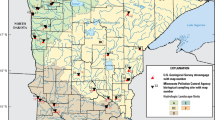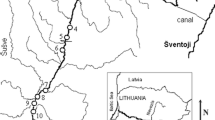Abstract
The dominant environmental determinants of aquatic communities have been a persistent topic for many years. Interactions between natural and anthropogenic characteristics within the aquatic environment influence fish communities in complex ways that make the effect of a single characteristic difficult to ascertain. Researchers are faced with the question of how to deal with a large number of variables and complex interrelationships. This study utilized multiple approaches to identify key environmental variables to fish communities of the Fox River Basin in Illinois: Pearson and Spearman correlations, an algorithm based on information theory called mutual information, and a measure of variable importance built into the machine learning algorithm Random Forest. The results are based on a dataset developed for this study, which uses a fish index of biological integrity (IBI) and its ten component metrics as response variables and a range of environmental variables describing geomorphology, stream flow statistics, climate, and both reach-scale and watershed-scale land use as independent variables. Agricultural land use and the magnitude and duration of low flow events were ranked by the algorithms as key factors for the study area. Reach-scale characteristics were dominant for native sunfish, and stream flow metrics were rated highly for native suckers. Regression tree analyses of environmental variables on fish IBI identified breakpoints in percent agricultural land in the watershed (~64 %), duration of low flow pulses (~12 days), and 90-day minimum flow (~0.13 cms). The findings should be useful for building predictive models and design of more effective monitoring systems and restoration plans.




Similar content being viewed by others
References
Aadland LP (1993) Stream habitat types: their fish assemblages and relationship to flow. N Am J Fish Manag 13:790–806
Adams LW (2005) Urban wildlife ecology and conservation: a brief history of the discipline. Urban Ecosys 8:139–156
Allan JD (2004) Landscapes and riverscapes: the influence of land use on stream ecosystems. Annu Rev Ecol Syst 35:257–284
Allan JD, Erickson DL, Fay J (1997) The influence of catchment land use on stream integrity across multiple spatial scales. Freshwater Biol 37:149–161
Archfield S, Vogel R (2010) Map correlation method selection of a reference streamgage to estimate daily streamflow at ungaged catchments. Water Resour Res 46. doi:10.1029/2009WR008481
Barbour MT, Gerritsen J, Snyder BD, Stribling JB (1999) Rapid bioassessment protocols for use in wadeable streams and rivers: periphyton, benthic macroinvertebrates, and fish. EPA 841-B-99-002. US-EPA, Washington, DC
Bartosova A (2008) Fox River watershed investigaiton: Stratton Dam to the Illinois River Phase II, analyses of biological data. Illinois State Water Survey Contract Report 2008-09, Champaign, IL
Breiman L (1996a) Bagging predictors. Mach Learn 24:123–140
Breiman L (1996b) Heuristics of instability and stabilization in model selection. Ann Stat 24:2350–2383
Breiman L (2001) Random forests. Mach Learn 45:5–32
Breiman L, Friedman JH, Olshen R, Stone CJ (1984) Classification and regression trees. Wadsworth International Group, Belmont, CA
Brenden TO, Wang L, Seelbach PW, Clark RD, Wiley MJ, Sparks-Jackson BL (2008) A spatially constrained clustering program for river valley segment delineation from GIS digital river networks. Environ Modell Softw 23:638–649
Brind’Amour A, Boisclair D, Legendre P, Borcard D (2005) Multiscale spatial distribution of a littoral fish community in relation to environmental variables. Limnol Oceanogr 50:465–479
Brown LR, May JT, Rehn AC, Ode PR, Waite IR, Kennen JG (2012) Predicting biological condition in southern California streams. Landsc Urban Plan 108:17–27
Cao Y, Huang J, Cummings K, Holtrop AM (2013) Modeling changes of stream mussel diversity and abundance in an agriculturally-dominated landscape. Freshw Sci 32:1205–1218
Cao Y, Stodola A, Douglass S, Shasteen D, Cummings K, Holtrop AM (2015) Modeling and mapping the distribution, diversity, and abundance of freshwater mussels (Family Unionidae) in wadeable streams of Illinois, USA. Freshwater Biol 60:1379–1397
Capon SJ, Lynch AJ, Bond N, Chessman BC, Davis J, Davidson N, Finlayson M, Gell PA, Hohnberg D, Humphrey C, Kingsford RT, Nielsen D, Thomson JR, Ward K, Mac Nally R (2015) Regime shifts, thresholds and multiple stable states in freshwater ecosystems; a critical appraisal of evidence. Sci Total Environ. doi:10.1016/j.scitotenv.2015.02.045
Carlisle DM, Falcone J, Meador MR (2009) Predicting the biological condition of streams: use of geospatial indicators of natural and anthropogenic characteristics of watersheds. Environ Monit Assess 151:143–160
Cover TM, Thomas JA (2006) Elements of information theory. Wiley, New York
Culp JM, Armanini DG, Dunbar MJ, Orlofske JM, Poff NL, Pollard AI, Yates AG, Hose GC (2010) Incorporating traits in aquatic biomonitoring to enhance causal diagnosis and prediction. Integr Environ Assess Manag 7:187–197
Cutler DR, Edwards T, Beard K, Cutler A, Hess K, Gibson J, Lawler J (2007) Random forests for classification in ecology. Ecology 88:2783–2792
D’Ambrosio JL, Williams LR, Witter JD, Ward A (2009) Effects of geomorphology, habitat, and spatial location on fish assemblages in a watershed in Ohio, USA. Environ Monit Assess 148:325–341
de Matos Simoes R, Emmert-Streib F (2012) Bagging statistical network inference from large-scale gene expression data. PLoS ONE. doi:10.1371/journal.pone.0033624
Detenbeck NE, DeVore PW, Niemi GJ, Lima A (1992) Recovery of temperate-stream fish communities from disturbance: a review of case studies and synthesis of theory. Environ Manag 16:33–53
Durance I, Lepichon C, Ormerod SJ (2006) Recognizing the importance of scale in the ecology and management of riverine fish. River Res Appl 22:1143–1152
Dyer SD, White-Hull CE, Wang X, Johnson TD, Carr GJ (1998) Determining the influence of habitat and chemical factors on instream biotic integrity for a Southern Ohio watershed. J Aquat Ecosyst Stress Recovery 6:91–110
Efron B (1979) 1977 Rietz Lecture - Bootstrap methods - another look at the jackknife. Ann Stat 7:1–26
Fausch KD, Torgersen CE, Baxter CV, Li HW (2002) Landscapes to riverscapes: bridging the gap between research and conservation of stream fishes. Bioscience 52:483–498
Francois D, Rossi F, Wertz V, Verleysen M (2007) Resampling methods for parameter-free and robust feature selection with mutual information. Neurocomputing 70:1276–1288
Frimpong EA, Sutton TM, Engel BA, Simon TP (2005) Spatial-scale effects of relative importance of physical habitat predictors of stream health. Environ Manag 36:899–917
Frissell CA, Liss WJ, Warren CE, Hurley MD (1986) A hierarchical framework for stream habitat classification. Environ Manag 10:199–214
Frothingham KM, Rhoads BL, Herricks EE (2002) A multiscale conceptual framework for integrated ecogeomorphological research to support stream naturalization in the agricultural Midwest. Environ Manag 29:16–33
Grantham TE, Viers JH, Moyle PB (2014) Systematical screening of dams for environmental flow assessment and implementation. Bioscience 64:1006–1018
Genuer R, Poggi JM, Tuleau-Malot C (2010) Variable selection using random forests. Pattern Recogn Lett 31:2225–2236
Griffiths GA, Clausen B (1997) Streamflow recession in basins with multiple water storages. J Hydrol 190:60–74
Hacine-Gharbi A, Ravier P, Harba R, Mohamadi T (2012) Low bias histogram-based estimation of mutual information for feature selection. Pattern Recogn Lett 33:1302–1308
Harrold T, Sharma A, Sheather S (2001) Selection of a kernel bandwidth for measuring dependence in hydrologic time series using the mutual information criterion. Stoch Environ Res Risk Assess 15:310–324
Hejazi MI, Cai X (2009) Input variable selection for water resources systems using a modified minimum redundancy maximum relevance (mMRMR) algorithm. Adv Water Resour 32:582–593
Hilderbrand RH, Utz RM, Stranko SA, Raesly RL (2010) Applying thresholds to forecast potential biodiversity loss from human development. J N Am Benthol Soc 29:1009–1016
Hildrew AG, Giller PS (1994) Patchiness, species interactions and disturbance in the stream benthos. In: Giller PS, Hildrew AG, Raffaelli DG (eds) Aquatic ecology: scale, pattern and process. Blackwell Science, London, pp 21–62
Hochachka WM, Caruana R, Fink D, Munson A, Riedewald M, Sorokina D, Kelling S (2007) Data-mining discovery of pattern and process in ecological systems. J Wildl Manag 71:2427–2437
Holtrop AM, Day D, Dolan C, Epifanio J (2005) Ecological classification of rivers for environmental assessment and management: stream attribution and model preparation. Illinois Natural History Survey Technical Report 2005/04, Springfield, IL
Hynes HBN (1975) The stream and its valley. Verh Internat Verein Limnol 19:1–15
Illinois Department of Natural Resources (IDNR) (2010) Fisheries manual of operation: field sampling protocols for rivers and streams. IDNR Division of Fisheries and Illinois Natural History Survey, Springfield, IL
Karr JR, Dudley DR (1981) Ecological perspective on water-quality goals. Environ Manag 5:55–68
Karr JR, Fausch KD, Angermeier PL, Yant PR, Schlosser IJ (1986) Assessing biological integrity in running waters: a method and its rationale. Ill Nat Hist Surv Spec Publ 5:28
King RS, Baker ME (2010) Considerations for analyzing ecological community thresholds in response to anthropogenic environmental gradients. J N Am Benthol Soc 29:998–1008
King RS, Baker ME, Kazyak PF, Weller DE (2011) How novel is too novel? Stream community thresholds at exceptionally low levels of catchment urbanization. Ecol Appl 21:1659–1678
Knapp VH, Ortel TW, Larson RS (1991) Hydrologic modeling of the Fox River Watershed. Illinois State Water Survey, SWS Contract Report 518, Champaign IL
Kovalenko KE, Brady VJ, Brown TN, Ciborowski JJH, Danz NP, Gathman JP, Host GE, Howe RW, Johnson LB, Niemi GJ, Reavie ED (2014) Congruence of community thresholds in response to anthropogenic stress in Great Lakes coastal wetlands. Freshw Sci 33:958–971
Lake PS (2003) Ecological effects of perturbation by drought in flowing waters. Freshw Biol 48:1161–1172
Lammert M, Allan JD (1999) Assessing biotic integrity of streams: effects of scale in measuring the influence of land use/cover and habitat structure on fish and macroinvertebrates. Environ Manag 23:257–270
Legg PA, Rosin PL, Marshall D, Morgan JE (2013) Improving accuracy and efficiency of mutual information for multi-modal retinal image registration using adaptive probability density estimation. Comput Med Imag Grap 37:597–606
Liaw A, Wiener M (2002) Classification and regression by randomForest. R News 2(3):18–22
Lyons J, Wang L, Simonson TD (1996) Development and validation of an index of biotic integrity for coldwater streams in Wisconsin. N Am J Fisheries Manag 16:241–256
Marzin A, Verdonschot PFM, Pont D (2013) The relative influence of catchment, riparian corridor, and reach-scale anthropogenic pressures on fish and macroinvertebrate assemblages in French rivers. Hydrobiologia 704:375–388
Mathews R, Richter BD (2007) Application of the indicators of hydrologic alteration software in environmental flow setting. J AWRA 43:1400–1413
Moore RD (1997) Storage-outflow modelling of streamflow recessions, with application to a shallow-soil forested catchment. J Hydrol 198:261–270
Osborne LL, Wiley MJ (1998) Empirical relationships between land use/cover and stream water quality in an agricultural watershed. J Environ Manag 26:9–27
Page LM, Burr BM (1991) A field guide to freshwater fishes of North America north of Mexico. Houghton Mifflin Company, Boston
Paul MJ, Meyer JL (2001) Streams in the urban landscape. Annu Rev Ecol Syst 32:333–365
Peres-Neto PR, Cumming GS (2010) A multi-scale framework for the analysis of fish metacommunities. Am Fish Soc Symp 73:235–262
Pescitelli SM, Rung RC (2009) Fish assemblages and stream conditions in the Fox River Basin: Spatial and Temporal Trends, 1996–2007. Illinois Department of Natural Resources, Division of Fisheries, Region 2, Streams Program. April 2009
Poff NL (1997) Landscape filters and species traits: towards mechanistic understanding and prediction in stream ecology. J N Am Benthol Soc 16:391–409
Poff NL, Allan JD, Bain MB, Karr JR, Prestegaard KL, Richter BD, Sparks RE, Stomberg JC (1997) The natural flow regime. Bioscience 47:769–784
Rathert D, White D, Sifneos JC, Hughes RM (1999) Environmental correlates of species richness for native freshwater fish in Oregon, USA. J Biogeogr 26:257–273
Reice SR, Wissmar RC, Naiman RJ (1990) Disturbance regimes, resilience, and recovery of animal communities and habitats in lotic ecosystems. Environ Manag 14:647–659
Richter BD, Baumgartner JV, Powell J, Braun DP (1996) A method for assessing hydrologic alteration within ecosystems. Conserv Biol 10:1163–1174
Roth NE, Allan JD, Erickson DL (1996) Landscape influences on stream biotic integrity assessed at multiple spatial scales. Landsc Ecol 11:141–156
Schindler S, von Wehrden H, Poirazidis K, Hochachka WM, Wrbka T, Kati V (2015) Performance of methods to select landscape metrics for modelling species richness. Ecol Model 295:107–112
Schueler T (1994) The importance of imperviousness. Watershed Protection Tech 1:100–111
Scott WB, Crossman EJ (1973) Freshwater fishes of Canada. Bull Fish Res Board Can 184:1–966
Shannon CE (1948) A mathematical theory of communication. Bell Syst Tech J 27(379–423):623–656
Smogor R (2002) Draft manual for calculating index of biotic integrity scores for streams in Illinois. Illinois EPA, Bureau of Water, Division of Water Pollution Control, Springfield, IL
Snyder CD, Young JA, Villella R, Lemarie DP (2003) Influences of upland and riparian land use patterns on stream biotic integrity. Landsc Ecol 18:647–664
Steen PJ, Zorn TG, Seelbach PW, Schaeffer JS (2008) Classification tree models for predicting distributions of Michigan stream fish from landscape variables. T Am Fish Soc 137:976–996
Steuer R, Kurths J, Daub CO, Weise J, Selbig J (2002) The mutual information: detecting and evaluating dependencies between variables. Bioinformatics 18:S231–S240
Sundermann A, Gerhardt M, Kappes H, Haase P (2013) Stressor prioritization in riverine ecosystems: which environmental factors shape benthic invertebrate assemblage metrics? Ecol Indic 27:83–96
United States Environmental Protection Agency (USEPA) (2006) Wadeable streams assessment: a collaborative survey of the nation’s streams. EPA 841-B-06-002. Office of Research and Development Office of Water, US-EPA, Washington, DC
Verikas A, Gelzinis A, Bacauskiene M (2011) Mining data with random forests: A survey and results of new tests. Pattern Recogn 44:330–349
Villeneuve B, Souchon Y, Usseglio-Polatera P, Ferreol M, Valette L (2015) Can we predict biological condition of stream ecosystems? A multi-stressors approach linking three biological indices to physico-chemistry, hydromorphology and land use. Ecol Indic 48:88–98
Walsh CJ, Fletcher TD, Ladson AR (2005) Stream restoration in urban catchments through redesigning stormwater systems: looking to the catchment to save the stream. J N Am Benthol Soc 24:690–705
Walters DM, Roy AH, Leigh DS (2009) Environmental indicators of macroinvertebrate and fish assemblage integrity in urbanizing watersheds. Ecol Indic 9:1222–1233
Wang L, Lyons J, Kanehl P, Gatti R (1997) Influences of watershed land use on habitat quality and biotic integrity in Wisconsin streams. Fisheries 22:6–12
Wang L, Lyons J, Kanehi P, Bannerman R, Emmons E (2000) Watershed urbanization and changes in fish communities in southeastern Wisconsin streams. J Am Water Resour Assoc 36:1173–1189
Wang L, Lyons J, Kanehl P, Bannerman R (2001) Impacts of urbanization on stream habitat and fish across multiple spatial scales. Environ Manag 28:255–266
Ward JV (1998) Riverine landscapes: biodiversity patterns, disturbance regimes, and aquatic conservation. Biol Conserv 83:269–278
Weigel BM, Robertson DM (2007) Identifying biotic integrity and water chemistry relations in nonwadeable rivers of Wisconsin: toward development of nutrient criteria. Environ Manag 40:691–708
Weins JA (2002) Riverine landscapes: taking landscape ecology into the water. Freshw Biol 47:501–515
Wiley MJ, Osborne LL, Larimore RW (1990) Longitudinal structure of an agricultural prairie river system and its relationship to current stream ecosystem theory. Can J Fish Aquat Sci 47:373–384
Wilkins P, Cao Y, Heske E, Levengood J (2015) Influence of a forest preserve on aquatic macroinvertebrates, habitat quality, and water quality in an urban stream. Urban Ecosyst. doi:10.1007/s11252-015-0464-6
Woznicki SA, Nejadhashemi AP, Ross DM, Zhang Z, Wang L, Esfahanian AH (2015) Ecohydrological model parameter selection for stream health evaluation. Sci Total Environ 511:341–353
Yang YCE, Cai X, Herricks EE (2008) Identification of hydrologic indicators related to fish diversity and abundance: a data mining approach for fish community analysis. Water Resour Res 44. doi:10.1029/2006WR005764
Acknowledgments
The authors would like to thank the reviewers for their valuable time and suggestions. We would also like to thank Ying Wang and Mary Yaeger for their contributions to the manuscript. The project was supported by NSF grant CBET-0747276.
Author information
Authors and Affiliations
Corresponding author
Electronic supplementary material
Below is the link to the electronic supplementary material.
Rights and permissions
About this article
Cite this article
Schnier, S., Cai, X. & Cao, Y. Importance of Natural and Anthropogenic Environmental Factors to Fish Communities of the Fox River in Illinois. Environmental Management 57, 389–411 (2016). https://doi.org/10.1007/s00267-015-0611-0
Received:
Accepted:
Published:
Issue Date:
DOI: https://doi.org/10.1007/s00267-015-0611-0




